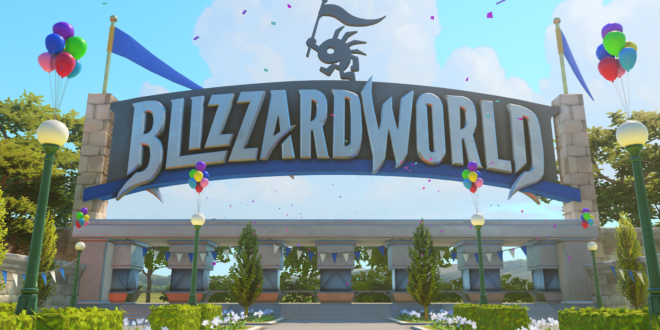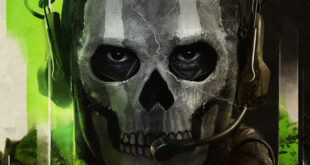Activision Blizzard just had its biggest week of the year. Its annual Call of Duty behemoth was launched at retail to strong sales figures, while BlizzCon gathered tens of thousands of the company’s most faithful fans together.
One big announcement was for a Disneyland-esque Overwatch map, celebrating the company’s biggest titles in a virtual themepark: BlizzardWorld. It may be little more than a coincidence, but only a few weeks beforehand we sat down with Tim Kilpin, an ex-Disney executive, who is now president and CEO of Activision Blizzard’s new consumer products group.
We discussed the unique strengths that gaming franchises have over their non-gaming competition and the new division’s ambitious plans for some of the most revered names in gaming today, including the Call of Duty movie and Overwatch’s esports expansion.
FRANCHISES ASSEMBLE!
Of course, Activision and Blizzard have long extended their brands beyond the games themselves, into merchandise for instance, but the companies felt a more integrated approach was needed to get the best from these IPs.
“What we’re building now is not game title, game title, game title,” explains Kilpin, gesticulating a series of boxes. “We’re truly starting to think about these as franchises and recognise that [they] have the potential to reach across a multiplicity of platforms.
“It’s working in gaming, of course, but it can also work in linear content, so we set up a studio to do that,” Kilpin says, referring to Activision Blizzard Studios, which is producing Skylanders Academy and the upcoming Call of Duty movies.
“It can also work more strongly than it’s worked in consumer products,” Kilpin continues. “Our challenge to some degree has been a disjointed approach across the divisions, it was buried in each of the divisions up to that point, it was a little bit ancillary.”
The new division will function across Activision, Blizzard and King as well. “We wanted to level it up, pull it up into a division of its own, which gave it visibility internally, gave it visibility with our licensing partners and also with retailers.”
THE GAMING EDGE
That visibility allows the division to better explain the potential strength of its franchises. Kilpin has been talking to partners at BLE, telling them “we’re a platform and a portfolio, these franchises exist across multiple platforms. So it’s not just the game as a driver, but it’s linear content as a way to expand the audience and expand the opportunity. And then esports [too], because pull all that together and you’re talking about franchises that are frankly like no other.”
Activision’s ambition then is nothing less than a big console game, attached to a Marvel-style cinematic universe, which also doubles up as the NBA: “We call it ‘the franchises of the future’ because we actually believe that’s a fair way to describe it,” Kilpin says.
“Because of the way our audience has evolved digitally, and the level of engagement with these franchises, now they’ll play the game for hours upon hours upon hours and go back into it for the seasonal content, downloadable content, microtransactions. They are living inside that ecosystem for years, and just today Overwatch players are playing an average of two hours a day.”
That’s the equivalent of watching a franchise movie everyday, and even with 17 movies in the ‘Marvel cinematic universe’ that would still get tired pretty quickly.
LESS IS MORE
This big brand, franchise approach, looks to be a great fit with Activision’s shift to a smaller number of tentpole titles, rather than targeting numerous genre staples.
“We’re prioritising strategically, stepping back and saying Call of Duty has a specific kind of player, and so we want to maximise the opportunity with that audience, through the game, through linear media, through esports,” Kilpin says agreeably.
“Same thing with Overwatch. It has a different set of characteristics, the affinity for the characters themselves in that game is very strong, it’s to some degree a different audience, so we bring that in, and then we bring the opportunity for new content, for new storytelling. We’ve had over a quarter of a billion views of our short-form story-telling on Overwatch, so people are engaging with the world.
“The other thing I’m excited about is that there’s more planning going into that process, so there’s more thought about how these characters enter the universe. They can enter through gameplay, they can enter through storytelling, they can enter through merchandising. When we bring in the new [Overwatch] Junkertown Map, for example, there’s a level of coordination across all these elements that adds up cumulatively to a richer engagement. And that to us is new territory, and that’s where we think we can play and compete very effectively with the more traditional types of franchises.”
Pictured above: Candy Crush ice cream from UK brand Rossi was available to try at Activision’s BLE stand and MCV can report that all three flavours are delicious
POPCORN TIME
One of the most traditional starts for a big franchise is the blockbuster movie. But now it’s Activision that’s making the movie too. Films based on games don’t have the best reputation, so does the movie risk damaging Call of Duty’s wider reputation?
“Anytime you take a franchise as storied as this, with this kind of legacy, and expand it into a new form factor you have to be really careful, you’re absolutely right,” agrees Kilpin. “So frankly, if the script and the story isn’t right we won’t do it, it’s not one of those situations where someone is saying ‘I don’t care, just get it made’. That’s not what’s happening. We do think that if it’s done well it has the opportunity to expand the base audience beyond the traditional foundation that the game appeals to.”
Of course, expanding the audience of arguably the biggest gaming franchise on the planet is no small task: “As an M-rated game it’s a core audience and we do think there’s an opportunity to reach a little more broadly than that, if the storytelling is done well. That’s the key.”
Looking to this year’s highly-successful outing, we wonder if the historical setting means that commercial activity around the game, such as merchandise, has be dealt with more sensitively.
“We ended up putting together a programme around Call of Duty that is more thoughtful, more curated, to celebrate what the title is about, and there is some apparel that goes along with that, and we’ll do some accessories but it’s relatively limited,” Kilpin says. “We’re doing a really nice strategy guide with Prima that’s not just a guide itself, it’s a footlocker that has some other collectibles with it. It honours what we’re trying to do with WWII without being overly crass about it.”
So while this year is somewhat limited by its subject matter, Kilpin feels there’s plenty of space to grow over the next couple of years.
“There’s a lot on the horizon that we’re excited about in terms of the new storytelling, the new titles, and the live action feature film in 2019. We think there’s a lot more opportunity to expand what we’re doing. This
year, we’re being thoughtful and curative. The next couple of years beyond this will really be opportunities for us to expand.”
Coming back to films, we wonder if an Overwatch movie is a possibility. The franchise is still growing obviously, but the strength of the game’s characters and style makes it a mouth-watering possibility. Kilpin smiles and only says: “We would like that very much.”
OVERPOWERED
But Overwatch has other ambitions for now. Barely a day goes by recently without a new announcement concerning the upcoming Overwatch World League. The league is Blizzard’s brave top-down attempt to create a highly organised, franchised esport in the mould of today’s NBA or NFL. A far cry from the more typical organic, grassroots model that most take.
That level of organisation gives the publisher many advantages, compared to most esports outfits.
“It’s an ecosystem,” Kilpin says. “We’re creating the events, obviously we created the game, we’re creating the sponsorship opportunities, creating the media opportunities, streaming the games, telling stories about the characters and then we’re merchandising around it. So when you connect all those dots, you can keep someone who’s a fan in that ecosystem all the way through the process, and that’s exciting.”
That effectively means that Activision is acting as apparel-provider, Nike or Puma for example, to all twelve teams in the fledgling league.
“We’re creating all the products that will support this, particularly at launch, which as you might expect are the traditional kinds of things. We’re going to outfit the players, then we’re going to outfit the fans with some similar things, hats, tees, jerseys, etc. At the outset, we’ll make that stuff available ourselves and sell it through our online store, make it available in the arena. We believe over time that we’ll start to bring more licensees into that.
Activision isn’t just in control of the team’s real-world apparel though, it’s also outfitting the teams in the game, to tie in with their franchise colours.
“When the Shanghai Dragons and the Dallas Fuel face off, not only will the teams be in their home and away looks, but the characters in the game will reflect that. It opens up this whole new opportunity, particularly as people build affinity with those teams.”
ACTIVISION ACTIVATION
Browsing to the Overwatch YouTube channel while writing this article, the video pinned to autoplay at the top of the page isn’t about a new game feature, an update or even the near-endless announcements for Overwatch’s World League, instead it’s an advert for a new 12in statuette of the popular Genji character, which costs $150 dollars direct from Blizzard. The video has 185,000 views to date. It’s the kind of joined-up thinking that Activision Blizzard, and many other companies, need to show if they’re to make the most of their franchises, and Kilpin agrees.
“We have a gear store that’s active today and we’re about to launch a version of that in Europe. There is a link to move from Battle.net today to that, though I’d say it’s not yet optimised, there’s a recognition on all our parts that it’s good to keep those consumers in the ecosystem if you can. So what you’ll see is us getting more direct about that, so you’re not just shopping for digital merchandise, you’re shopping for physical merchandise as well.”
The possibilities are pretty clear. For example Blizzard knows which character a given player is keen on at any given time, and it should be able to target them with appropriate products to match.
“Yes, we’re not there yet, but strategically that’s part of the plan.The consumer is very comfortable living in that digital ecosystem and staying in that ecosystem, so we want to serve up the opportunity to that consumer. We have some work to do, but we’re on our way.”
However, Activision is drawing the line at making players earn the right to buy certain items in-game before offering them in the store, as mobile titles have experimented with.
“We’ve talked about that, but our point of view is that the people creating the game want to create the best possible game experience, they are wary, and so are we frankly, of creating that barrier. If someone wants to go and get the T-shirt, mug or figurine, you don’t really want to put a hurdle in the way. We haven’t found a solution to that which is elegant and fan friendly.”
No sign yet of a Blizzard theme park then, but the ex-Disney man certainly isn’t excluding anything in his efforts to build the company’s games into world-beating franchises and with an enviable mix of engagement, characters, storytelling and esports, it looks like he’s got something potentially very special.

 MCV/DEVELOP News, events, research and jobs from the games industry
MCV/DEVELOP News, events, research and jobs from the games industry




